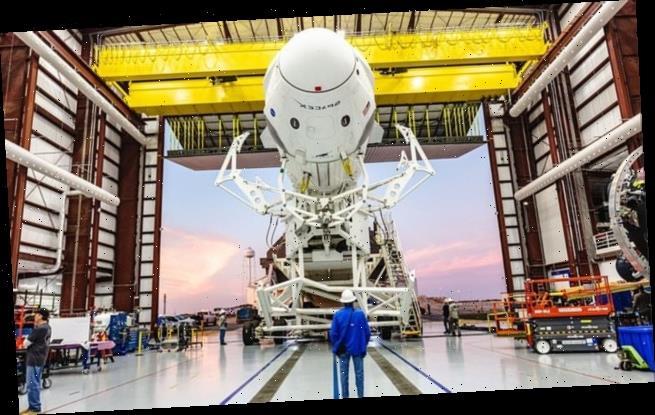SpaceX to launch four private passengers into orbit around Earth by as soon as late 2021 thanks to partnership with space tourism company
- SpaceX may launch its first space tourists as soon as late 2021 or early 2022
- The news comes amid a new partnership with Adventures, a space tourism firm
- Four passengers will orbit Earth in Space’x Crew Dragon for five days
- Training for the voyage will take place over a few weeks
- Space Adventures said voyage cost will be comparable to other opportunities
- A trip to the ISS costs about $35,000 per night
SpaceX says it will be ready to launch four pioneering space tourists into orbit in just two years.
Thanks to a partnership between the Elon Musk-owned aerospace company and space tourism company, Space Adventures, SpaceX says that its first private citizen-chartered flight around Earth could come as soon as late 2021 or early 2022.
Space Adventures has already helped launch tourists into space, specifically the International Space Station, using Russia’s Soyuz Rocket.
‘This historic mission will forge a path to making spaceflight possible for all people who dream of it, and we are pleased to work with the Space Adventures’ team on the mission,’ SpaceX president and COO Gwynne Shotwell said in a statement.
SpaceX’s Crew Dragon capsule (pictured) has conducted unmanned flights into space but has yet to carry its first astronauts. Once cleared for human flight, the capsule, thanks to a new partnership between the company and SpaceAdventures will send four tourists into orbit around Earth for five days
According to Space Adventures, the mission will last about five days and would launch from Cape Canaveral in Florida. Training for the mission would take a few weeks according to the company.
Once launched into orbit aboard SpaceX’s Crew Dragon capsule – a current work-in-progress – passengers will ‘free-fly’ around the Earth without docking with the ISS.
Space Adventures says that will attempt to reach two to three times the altitude of the International Space Station which orbits 250 miles away from Earth’s surface.
‘At an altitude of 3x the ISS, the view is 10x, as it increases by square of altitude,’ said Eric Anderson, CEO of Space Adventures, on Twitter.
While neither company provided a specific price for the flight, a representative from Space Adventures told MailOnline that it will be be ‘in the range as other orbital spaceflight opportunities.’
The feasibility of SpaceX and Space Adventures’ goal of taking private passengers into space will be contingent on the progress of the former company’s Crew Dragon capsule which is also being readied to transport NASA astronauts for the first time.
According to recent reports, SpaceX’s Crew Dragon first human-passengered launch could come as soon as May 7 if all tests go according to plan. Variables could, however, push the launch into late May or April.
Crew Dragon has experienced some issues in the past, including an explosion that happened during testing that has delayed the capsules mission to carry humans into space
The capsule has gone through ups and downs throughout the past several years. In April last year, an explosion engulfed the empty capsule in fire and smoke.
The incident was set off by a leaking component and completely destroyed the capsule – a glitch that has contributed to SpaceX’s delayed timeline for Crew Dragon, which it’s developing for NASA.
SpaceX and Space Adventures’ goals will mirror those announced by the ISS which in June of last year revealed that it will be taking private citizens on a per night basis.
A trip to space won’t come cheap, however, with life support systems and all necessary supplies considered, it will cost an eye-watering $35,000 per night at minimum.
WHAT IS SPACEX’ CREW DRAGON CAPSULE?
The March 2 test, the first launch of U.S. astronauts from U.S. soil in eight years, will inform the system design and operations (Artist’s impression)
The capsule measures about 20 feet tall by 12 feet in diameter, and will carry up to 7 astronauts at a time.
The Crew Dragon features an advanced emergency escape system (which was tested earlier this year) to swiftly carry astronauts to safety if something were to go wrong, experiencing about the same G-forces as a ride at Disneyland.
It also has an Environmental Control and Life Support System (ECLSS) that provides a comfortable and safe environment for crew members.
Crew Dragon’s displays will provide real-time information on the state of the spacecraft’s capabilities, showing everything from Dragon’s position in space, to possible destinations, to the environment on board.
Those CRS-2 Dragon missions will use ‘propulsive’ landings, where the capsule lands on a landing pad using its SuperDraco thrusters rather than splashing down in the ocean.
That will allow NASA faster access to the cargo returned by those spacecraft, and also build up experience for propulsive landings of crewed Dragon spacecraft.
Source: Read Full Article



